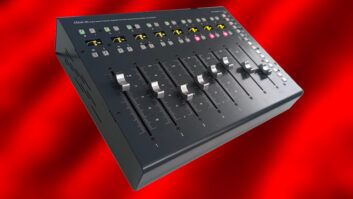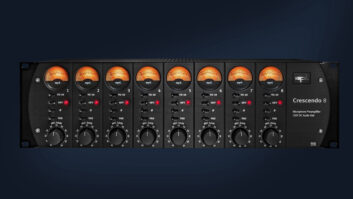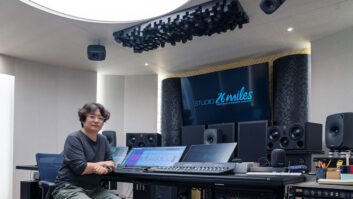Rather than presenting an entire soup-to-nuts studio this time, we’re looking at a targeted upgrade to a project studio dedicated to sound design and music production. We’ve noticed from studio operators that despite upgrading equipment fairly regularly, the crucial area of acoustics—both monitoring and treatment—often gets overlooked. With that in mind, this upgrade scenario focuses more than half the budget to acoustics. For the remaining equipment recommendations, rather than outlining a comprehensive studio, we lean toward exciting additions and high-end supplements to a meat-and-potatoes room.
For the following configuration, we assume you already have a fairly powerful Mac or Windows computer with a free Ethernet connection. Prices listed are MSRP.
MONITORING
Genelec’s Smart Active Monitoring technology is now a decade old, yet the latest models continue to improve the overall reliability, accuracy and flexibility, while making the calibration of multichannel monitoring setups even faster.
We’ll take that flexibility and run with the ability to toggle between 2.1, 5.1 and 7.1 setups, beginning with the Genelec 7360A 10-inch powered 300W SAM subwoofer ($2,850). This powerful woofer has a 19Hz low-frequency extension and AutoCal for aligning the volume, crossover, timing and EQ to room responses. It supports up to 7.1 analog or digital surround systems, and you want to be able to accommodate surround mixing for the cherry sound design and production projects.

Genelec 8350A monitor
For the left and right main channels, the Genelec 8350A 8-inch 200W bi-amped monitors ($2,595 each) rest on included Iso-Pod stands and employ a minimum diffraction design for ideal audio imaging. You can count on them to supply high audio output with low distortion; connect them via GLM Network, digital AES/EBU or analog XLR. Depending on your needs and budget, add three or five Genelec 8340A 6.5-inch 150W bi-amped monitors ($1,895 each) to round out a 5.1 or 7.1 setup. They feature the same design and sound profile of the 8350As but in a smaller size.
Finally, add the Genelec GLM 2.0 SAM Loudspeaker Management System ($495), a hardware/software calibration and management package.
Monitoring subtotal: $14,220 to $18,010
ACOUSTIC TREATMENT
A studio’s acoustic treatment often gets neglected even more than monitoring, so it’s time to go allout to complement your enviable new Genelecs. Assuming a rectangular studio room of approximately 12-15 feet by 16-20 feet, we’ll outfit it for a surround-sound setup. Some consulting with the manufacturers is recommended.
The Real Traps Mondo Surround Kit ($2,699) provides an excellent starting point. The kit has four Corner MondoTraps for extreme low-frequency absorption at the wall corners, six MicroTraps for the side walls or other fill-in points, and four MiniTraps for the rear and side walls. Each module is a membrane bass trap made of Fiberglas and metal that also absorbs mid and high frequencies. They are lightweight enough to mount with the included picture wire, bolts and screws, or on stands. They come in white, beige, gray or black.
To supplement the Real Traps, add four to eight Primacoustic Cumulus tri-corner bass traps ($130 each) to capture sound 100 Hz and up in the corners where the walls meet the ceiling and/or floor. I also recommend three or four Primacoustic Stratus Studio Ceiling Clouds ($230 each), depending on the size of your room. They use ceiling suspension hardware to hang above the listening position and reduce or eliminate reflections while enlarging the sweet spot. These also come in black, beige or gray.
Small studios often lament the lack of a vocal booth. If you have a relatively luxurious amount of space and budget, the ClearSonic IsoPac G ($1,725) supplies a strike-able vocal booth of 4-feet in diameter using a combination of clear panels and Sorber baffles. It fits one vocalist and could also be used for recording instruments.
If mounting to a rear wall or other wall is an option, the Primacoustic FlexiBooth ($449) is a 2-by-4-foot acoustic “cupboard” that unfolds to create a dry vocal zone that attenuates and separates room ambience. The most flexible and low-cost option, the Real Traps 11-pound Portable Vocal Booth ($299) mounts to any microphone boom stand and uses two absorptive panels to create a triangular area for recording vocals, guitar amps, etc.
Acoustic Treatment subtotal: $4,208 to $6,384
DAW/CONTROL SURFACES
Sometimes the question is not which DAW to use, but which secondary DAW to choose? After nearly three years of development, Bitwig Studio 2 ($399) has arrived to throw a wrench in the machine. While it won’t threaten Pro Tools’ rule, this major update has taken a huge step toward a fully modular device architecture that should appeal greatly to sound designers and experimental producers. The 75+ Bitwig internal devices (instruments, effects, generators, “containers,” etc.), as well as external plug-ins, now have modulation slots where you can load 24 new Modulators, including different types of envelopes, LFOs, sequencers and much more. This creates an incredibly powerful and flexible creative workflow to complement Bitwig’s fluid interface that blends its Clip Launcher with the timeline arrangement window.

Nektar Panorama P6 MIDI control surface
For a comprehensive MIDI control surface with rock-solid Bitwig Studio integration, look no further than the Nektar Panorama P6 ($659). With 61 full-size weighted keys, 12 drum pads, 16 encoders, nine faders, one motorized master fader and transport controls, it’s a DAW-controlling powerhouse and organizes everything on a detailed color display.
With a control script available online, the Ableton Live specialist Novation Launchpad Pro ($399) velocity- and pressure-sensitive 64-pad multifunction controller becomes a beast for Bitwig, as well. Its pad grid will do wonders for Bitwig Studio’s Clip Launcher, and its Scale mode lets you experiment with a new style of melodic composition.
DAW/control surfaces subtotal: $1,457
MICS & RECORDING
It’s never a bad time for a high-quality, large-diaphragm tube condenser microphone for a value price if you can find it. This year we did with the Lauten Audio LA-320 ($799), a cardioid pickup mic with built-in highpass and lowpass filters that sounds great for vocals and instruments up to 130 dB SPL.

MOTU 1248 interface
You may be set with an audio interface already, but if you need one with plenty of audio outputs for your 7.1 surround system, consider the MOTU 1248 ($1,495). With its four mic pre’s, two DIs, 8×12 analog I/O, 16 optical I/O, S/PDIF I/O, Word Clock and AVB Ethernet, Thunderbolt and USB 2 connections, it can accommodate a variety of setups and provides a 48-channel DSP onboard mixer with EQ, compression and effects controllable from a computer or wirelessly over iOS. It has enough analog outputs for your surround sound and for taking advantage of Bitwig Studio 2’s new ability to control CV analog gear.
If you’re serious about sound design, it may be time to step up your field recording game beyond a handheld recorder. The Sound Devices 702 ($2,225) gives you a pristine 2-track Compact Flash recorder that captures uncompressed PCM audio at resolutions up to 24-bit/192kHz, with a removable Li-ion battery. Outfit that recorder with a Sennheiser MKH 416 compact supercardioid shotgun interference microphone for stunningly directive recordings with very low self-noise. When taking it outside, protect it with the Rode Blimp 2 ($399) windshield and shockmount for shotgun mics.
If you’re not using USB-C yet, you will be soon enough. You always need more portable, reliable storage, as well, so pick up the Glyph Atom Portable SSD RAID 1TB solid-state drive ($449) for either USB 3.1 (USB-C), USB 3.0 or Thunderbolt 3.
Mics & recording subtotal: $6,616
ANALOG HARDWARE
We can’t recommend a studio without some real analog signal paths. With modular synthesizers enjoying a monumental comeback, the Moog Music Mother-32 analog semi-modular monosynth ($679) presents the perfect bridge to modular synthesis. It works as a stand-alone tabletop instrument for distinctively Moog sounds, or as a rackable module for expanding with other Mother-32s or with Eurorack systems. It has sequencer buttons that can be played like a keyboard, 32 patch points for interacting with other Eurorack gear, MIDI to CV conversion, external audio inputs, and of course, that creamy Moog filter and spaceage sound. You can’t go wrong by racking up three of them in the dedicated Moog 3-tier rack kit.
Analog hardware subtotal: $2,167, including patch cables and rack kit
PLUG-INS: EFFECTS AND DYNAMICS
During the past year, iZotope released both the killer VocalSynth transformative vocal effects plug-in and the revolutionary Neutron mix analysis and processing plug-in. You can get them both, along with the Ozone 7 Advanced mastering suite, Nectar 2 production suite, Trash 2 distortion and RX audio repair Plug-in Pack, in the Music Production Bundle 2 ($699), an extraordinary value for such a collection.

Celemony Melodyne Studio 4
A sound design and editing wunderkind, Celemony Melodyne Studio 4 ($699) lets you edit pitch-and-time correction to multiple tracks simultaneously in one window, sync click-track material with recordings made without a click, edit overtones of individual notes, and more.
What’s good for the sound designer is good for the producer, so we’ll add a few more marvels: Zynaptiq Morph 2 ($179) morphs two sounds in real-time and creates completely new textures from existing material. The wonderfully bizarre and twisted Glitchmachines really should offer a bundle, but in absence of that, we’ll recommend both Cataract and Quadrant ($49 each). Cataract absolutely rips audio files from the inside out with modulation sequencers and morphing, while Quadrant uses granular and FM modules and patching to generate sound and to process sound with unending variation.
Plug-ins—effects and dynamics subtotal: $1,675
PLUG-INS: INSTRUMENTS
While I hope you already have some kind of definitive library like EastWest Composer Cloud or Native Instrument Komplete, some remarkable new sampled collections and emerging synths demand your attention.

Softube Modular plug-in
Spectrasonics Keyscape ($399) culls 36 highly desirable keyboard instruments into an enormous and thoroughly detailed sample plug-in. Along with Yamaha pianos, Rhodes, Wurlitzer and Clavinets, there are gorgeous and ancient rarities like the dolceola, dulcitone and harpsichord, all in a form that’s the closest you’ll get to the real thing.
For orchestral and cinematic scores, the 55GB IK Multimedia Miroslav Philharmonik 2 collection ($499) fulfills nearly every wish with more than 2,500 instrument sounds of strings, woodwinds, brass, percussion and more, available in all types of timbres and articulations. To boot, 38 onboard effects include ConvoRoom convolution reverb and analog-modeled mastering processors.
Another way to get your modular fix without going full-bore into modular synths, the Softube Modular plug-in ($100) delightfully re-creates a modular synth using the most useful modules from Doepfer (inventor of Eurorack) at a tantalizing price, with interesting add-ons available for a nominal fee.
Finally, as the synth plug-in preset market has opened up for sound designers, the most popular instruments to design for have proved to be old favorites like NI Massive, Sylenth and Xfer Serum. However, applying heat from behind comes Reveal Sound Spire ($189) a multimode polymorphing oscillator synth combining the spirit of analog with the power of digital. Its powerful Unison Engine provides nine unison voices on each oscillator, which makes it a favorite for the huge leads and big basses that dominate electronic music, which is, after all, pop music these days.
Plug-ins: Instruments subtotal: $1,187
Grand total: $31,530 to $37,496. If you opted for 5.1 to save some money, go out and buy an Oculus Rift and prepare yourself for the coming wave in sound design for VR.







